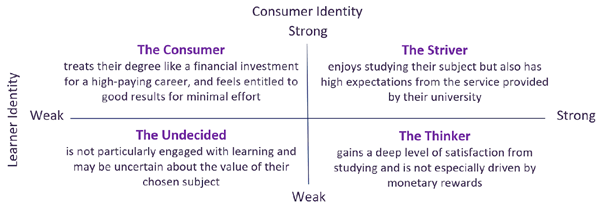Our identities, or who we think we are, influence how we think and how we behave. The traditional identity of a student is that of a “learner” or scholar, with an intrinsic interest in developing their own understanding and creating new knowledge. However, over the past two decades, with the marketisation of higher education, a new student identity has emerged in England and Wales, that of the “consumer”. This new identity is accompanied by attitudes and behaviours that are not necessarily conducive to learning, research shows. These include feeling entitled to receive a degree in return for paying tuition fees; thinking that grades are more important than learning; and complaining about difficult content. As a result, students with a strong consumer identity may be more likely to engage superficially in their studies.
- Purposefully building identity and belonging among students
- How to reconnect in a changed world
- Forget everything you think you know about online engagement
A tool for developing students’ learner identity
Identities are social, meaning that they are influenced and formed by the groups to which we belong. When people feel part of a group, they are motivated to establish a shared set of values and beliefs, and to coordinate their behaviour to promote the interests of the group. With this in mind, I developed a workshop and supporting resources to enable students to assess their educational identities as “learners” and “consumers” and to discuss these identities with their peers and tutors. The workshop provides a structured space for students and educators to co-create a shared group understanding of attitudes and behaviours that support learning within their own disciplinary context.
The workshop structure is outlined below. It can be completed in just one hour with a small group of students (up to 20) and can be run in an online or face-to-face format, for students at all levels of study, including those transitioning to university.
Workshop structure
Step 1: Students complete questionnaire to establish strength of consumer and learner identities and discover student “type” (10 min)
Step 2: Educator presents research on identities using PowerPoint slides provided (10 min)
Step 3: In breakout rooms/small groups students consider discussion questions (25 min)
Step 4: Educator leads plenary to create a summary of attitudes and behaviours that support learning, in order to create a shared social identity as a learner (15 min).
Step 1: Students complete questionnaire
First, students complete a short online questionnaire that calculates the strength of their learner and consumer identities. Students should be reassured that there are no right or wrong answers, and that they will not be asked to share their score with anyone.
To assess their learner identity, students rate the extent to which 22 statements are true of them. Example statements include: I prefer course material that arouses my curiosity, even if it is difficult to learn; and I prefer course material that really challenges me so I can learn new things.
To assess their consumer identity, they rate their level of agreement with 18 statements. Example statements include: Because I will have paid to attend my institution, it will owe me a degree; and If I could get a well-paying job without going to university, I would not be here.
Based on their responses, students are categorised as one of four student ‘types’.

The Consumer: A weak learner identity and strong consumer identity. They view their degree more as a financial investment or training for a high-paying career than as an opportunity to understand a subject because it is interesting in its own right.
The Striver: A strong learner identity and strong consumer identity. A well-paid career is important to them and they will have high expectations from the service provided by their university. However, they will also be passionate about their subject and enjoy studying.
The Thinker: A strong learner identity and weak consumer identity. This is because they gain a deep level of satisfaction from studying and enjoy finding out about new ideas. They are not especially driven by money and do not feel entitled to a degree as a result of paying tuition fees.
The Undecided: A weak learner identity and weak consumer identity. This is because they do not seem particularly engaged with their university or learning at a substantial level. Perhaps they are not sure whether university is the right place for them at this time, and perhaps their chosen subject of study is not appropriate at the moment.
Again, students should be reassured that they will not be asked to share their identity type unless they want to. They should also be told that there is not necessarily a “best” type but that each type has its relative advantages and disadvantages.
Step 2: What the research says
Tutors should talk students through research on student identities, which is grounded in educational and social psychology and co-produced with my students. It shows students who identify more strongly as consumers, have lower-quality motivation for learning, less effective approaches to learning, identify less with other students in their discipline, and have lower academic attainment. It is clear that if we want students to be fully engaged in their education and achieve their potential, we should resist treating them as consumers and foster their identities as learners.
Educators can present this research however they wish but I have created a series of PowerPoint slides as part of the workshop resources which they may find helpful. Here it is important to emphasise the positive impact of learner identities on studying and the negative impact of consumer identities.
Step 3: Group discussion
Break the class into small groups or breakout rooms, and ask them to reflect upon their learner identities and the impact of these different attitudes on studying and academic performance.
To guide the reflection, ask them to focus on a number of discussion questions such as:
- Reflect on why you decided to attend university? What were your reasons for going? Do these reasons relate to the student type Consumer, Striver, Thinker or Undecided?
- How does the Thinker type differ from the Striver and Consumer types? Consider their expectations of their education, their attitudes towards learning, and their behaviours on campus and in the classroom.
- Is your student type fixed or is it flexible? What factors might influence whether your learner and consumer identities get stronger or weaker?
Try to spend some time with each group to hear about their views, ensure everyone is participating and where necessary advance the debate.
Step 4: Plenary
The aim of the plenary is for educators and students to co-create a summary of attitudes and behaviours that support learning in their discipline, in order to create a shared social identity as a student learner.
Students could be given the heading: “Being a successful student in my discipline means…”, and then be asked to agree on a set of attitudes and behaviours that enable learning. For instance, “…being curious about new ideas by using resources available to me to find out more” or “…asking questions of my peers or tutor if I don’t understand something”. The final list can be posted in their online learning platform and revisited during personal tutoring sessions to support deeper student learning.
Learner identities boosted
Feedback from the workshop so far has been very positive, and it has been adopted by a number of different courses across the UK. One student said it “gives me more of an identity as a student and creates more confidence in my ability” and another said it “enables you to understand your learning and how to adapt it to maximise your experience and learning on the course”.
All the materials are freely available to use on the Student Identities and Inclusion Projects website.
Louise Taylor Bunce is principal lecturer, student experience, in the department of sport, health sciences and social work at Oxford Brookes University.




comment2
(No subject)
(No subject)